
|
RN001. This is a heavy ring, originally cast from bronze and
made for one of the smaller fingers of a man's hand...
It has a slightly pitted texture to it that leaves a grainy finish
that looks very old and elegant. There is some delicate etching around
the bezel, and a simple pattern on the top, of two swirls meeting...
probably symbolizing harmony, balance, and perhaps infinity. The back of
the ring where the original sprue was (the channel where the molten metal
was poured into the original mold of the ring) still has a low remnant
of the sprue which has been shaped and carved with a flower design.
This is a particularily sophisticated piece... available in sizes
6.5, 7.5, 10
$85.00 US |

|
RN002. This smaller ring has a thick and well decorated
band. There are small bits of etching, relief and design all around
the band culminating in a sprue decorated with a few diagonal lines.
The bezel of the ring is flower shaped and has a cross type design
impressed into it with an engraver's tool.
This was a silver woman's ring, probably Islamic, from the 11th
Century or so... available in sizes 5.5, 6.5, 7.5
$65.00 US |
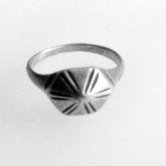
|
RN003. This Islamic ring was found in Bulgaria and probably
originated in the 15th to 16th Century. It has a narrow band and
a patterned raised design on it that could have represented the sun...
This ring has a very modern look to it. available in sizes 5 to 8.5
$55.00 US |
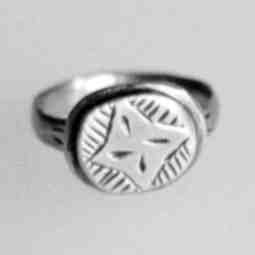
|
RN004. This Byzantine ring was found in Bulgaria and was
originally cast in bronze. The design shows up much better in silver,
and denotes a religious cross. Designs like this would be used as
seals to impress in wax to notarize documents. The design sits raised
lightly on a slightly wider base, and the band is flat and even all around...
This is a copy of the first ancient ring that I owned, but I have since
seen similar ones in the reference books...
available in sizes 6 and up...
$60.00 US |

|
RN005. This is our choice for a tiny and delicate ring.
It has a small 3 step pyramid on the top which is funnily enough a little
crooked... so when you look at it from the top it is not exactly
square, but very slightly tilted to the diagonal... it gives it a
sweet and quirky look.
This originally bronze ring is probably late Roman or early
Byzantine--we'll say from the 5th to 7th Century A.D.
available in sizes 5 and 8.5
$45.00 US
|
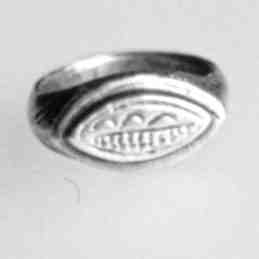
|
RN006. Eye rings were worn in Islamic countries to ward
away evil. This ring has an eye shaped bezel which has an etched
design within the eye, which looks sort of like Arabic script, but isn't
really. It is probably a design that was originally derived from
the decorative aspect of script...
There are also some lines of etching to each side of the center eye,
and the low sprue in the back is decorated with a series of vertical lines.
This is a very comfortable, solid ring that sits sturdily on the
finger... I have no more of this ring, but have one that has the
simple "eye" design with no pattern on it. Size 8 and 8.5.
$65.00 US |
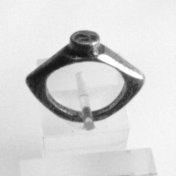
|
RN007. This flanged ring is typical of early Roman ones.
The catalog of the British Museum collection of ancient rings illustrates
a few similar types--often cast in gold, but also in silver and bronze.
This ring fits beautifully on one of the smallest finger of a woman's hand,
and is surprisingly very comfortable. It has a simple design carved
into the circular bezel, which may be a very abstraced portrait.
I would place this ring around the 3rd Century A.D... one available
in size 6
$60.00 US |
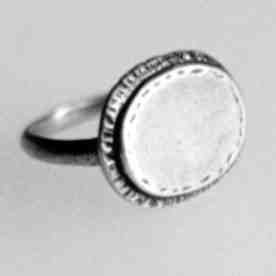
|
RN008. Photos cannot do justice to this Islamic beauty.
It has a wide, flat top on it that has no decorations other than a simple
dashed line around the edge of the oval. behind that is a ridge which
has small lines cut into it, almost like a shallow ruffle. On the
side of the oval which lies against the finger are lines radiating outwards
from the center of the oval... This ring is wonderful in it's simplicity...
available in sizes 5 up to 8
$70.00 US |
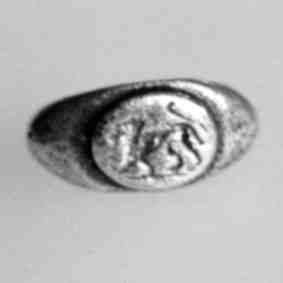
|
RN009. This ring is much more impressive than it looks here.
I have to figure out a way to photograph it that does it justice...
The seal at the front of this ring leaves an impression of a lion.
A very attractive symbol for men, both in classical times and today...
This was definitely a man's ring in the 1st or 2nd century of the Roman
empire. it is quite heavy and the ring is thickest at the sides so
that it kind of swells out from the sides of the intaglio of the lion...
We can only make this in limited sizes without affecting the shape
too much... available in sizes 7 to 10.5.
$85.00 US |
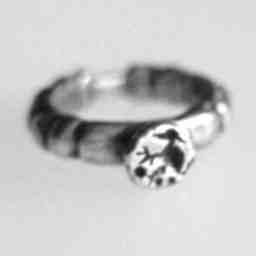
|
RN010. I have never seen a ring quite like this one before.
The very back of the the ring is an undecorated bar which is there so that
a cord can be tied neatly to the ring for wearing around the neck.
Rings like this, with distinctive seal images on them (this one is a small
bird with large feet, and three dots under it...) were important as signatures
in the signing of documents. They were more important as "signatures"
than as jewelry. This though, is a beautiful piece of jewelry.
The body of the ring is scalloped all the way around to the bar at the
back, and the bird seal stands up about 1/4" from the ring band...
available only in sizes 6 1/2 to 8.
$65.00 US |
|
|
|
|
|
|
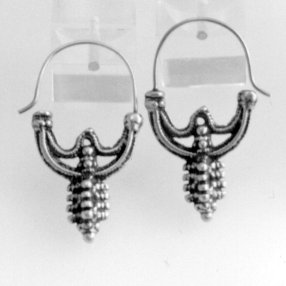
|
EA001. This beautiful pair of earrings comes from the Ottoman
Empire - an exotic culture centered on medieval Constantinople.
In the 15th Century these earrings may have cast in gold, but they are
equally beautiful in silver. This version is fairly heavy and not
for the most delicate of ears... but they sit very nicely, tilted
a little to the sides of the jawbone... This style of earrings is
well represented in books of ancient jewelry...
1 5/8" from top to bottom.
ALL SOLD
|
|
|
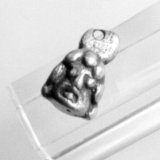
|
PE001. This pendant was originally cast in bronze and has the
look of a "lost wax" casting... where wax was sculpted to form the
design and then surrounded by a hard material like clay. The clay
would have been left to dry, the wax melted out, and the molten metal poured
in. A casting made this way would necessarily be "one of a kind"
since the original wax would be lost, and the mold would have been broken
after the first casting...
This is probably Phoenician from the 1st millenium B.C. There
is a face on both sides of this pendant, so it is referred to as "janiform."
It was originally excavated in Jordan... 3/4" high.
$65.00 US |

|
PE002. This is a wonderful pendant of a bull's head. It
was originally carved into a dark grey stone. The work is obviously
the type of artistry which inspired Picasso and his contemporaries in their
days of "tribal" and "exotic" explorations... I still haven't figured
out exactly which culture it came from, though it was found in the
Middle East, and I am certain would be dated B.C.... I just don't
know quite where and when...
This is really a striking piece which lies against the throat, strung
on a satin cord... 5/8" high.
ALL SOLD
|
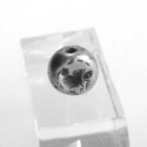
|
PE003. Originally a Sasanian (A.D. 224-651, called
Persis by the Greeks, now known as Persia) stamp seal carved
from carnelian stone, this bead translates beautifully into silver...
It has a wonderful little bird on it, which shows up very clearly if
you impress it into clay or fimo. It has a slight dashed line around
the flat side of the bead which adds a graphic touch to the design...
We send it to you on a black satin cord so you can wear it as the Sasanians
did... 3/8" across.
$45.00 US |
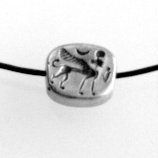
|
PE004. I was excited to find this bead (the original is made
of smooth black glass) because of the beautiful winged griffin pictured
on it... Winged creatures hold a particular fascination for me.
This magical griffin (or gryphon) who has the body of a lion, and the head
and wings of an eagle, also has a slice of moon above him, and a human
type figure in front of him... He symbolizes the destructive powers
of the "gods."
1/2" x 5/8"
ALL SOLD
|

|
PE005. This is a silver casting of a very unusual Sasanian
stamp seal. The original seal was carved out of a pale white
agate. The flat side of the seal portrays three standing figures.
When I originally came across this bead/seal I thought that it was cracked,
chipped and damaged on the rounded sides. Closer examination through
the grime showed that actually, there are carvings around the "back" of
the seal. There is a word or phrase that I have not yet been able
to translate as well as two birds that are carved in such a way that they
share the same head with their bodies angling off in different directions...
This bead looks small but it quite heavy, and really very very nice.
5/8" across... We deliver this strung on a black satin cord.
$65.00 US |
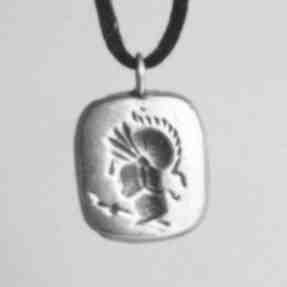
|
PE006. This little pendant doesn't qualify as being ancient.
It is though, a Victorian copy of an ancient theme. This was
originally a dark stone intalglio meant to be set in a bezel to make a
ring or pendant. It has a wonderful portraint of a warrior on it,
that is very graceful and very skillfully done. Right now we have
this illustrated with a very fine loop, but I think we will be making them
in the future with a wider bail type hanging loop.
The pendant (excluding loop) is 5/8" by 1/2".
We send this to you on a narrow black satin cord.
$45.00 US |
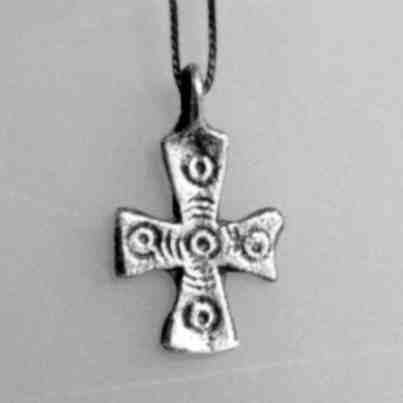
|
PE007. This is a small (1" high excluding loop) very typical
Byzantine cross. It seems that a zillion of these were made
out of bronze in the 8th to 10th centuries--all with the same circles in
the center and on the arms of each cross... They are so similar that
they could have almost been made from the same one mold--impossible of
course... but they must have been the crosses that the average person
wore.
ALL SOLD
|
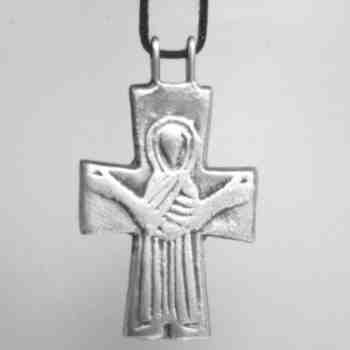
|
PE008. This Byzantine cross from Bulgaria has been
slightly adapted to make a truly striking pendant. Originally there
was half of a hinge attached to the lower portion of the cross. Since
it was broken, we removed the remaining parts from the casting...
This would normally have been only the front half of the cross. The
hinge at the bottom would have attached the front to a nearly identical
(but undecorated) back piece. The loops at the top would have interlocked
so that when a cord was passed through, the two sides would remain closed.
Inside this reliquary cross a pilgrim or a religious devotee would
have placed items of devotional and spiritual importance. These crosses
are found broken more often than not, and continued to be highly valued
and still worn in that state... 2 1/2" high.
ALL SOLD |
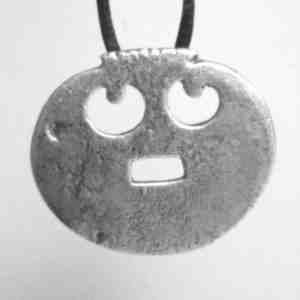
|
PE010. This is a charming pendant - probably an Islamic design
(over 1000 years old) that was probably originally some kind of belt ornament.
We added a couple of small loops on the back so that it can be worn on
a satin cord (or when you get it home you can use a silver chain or use
it as a centerpiece with an interesting collection of beads...) The
design is of two flowers facing away from each other...
It is very simple, and quite elegant in its simplicity...
1 1/4" by 3/4"... sent to you on a black satin cord...
$65.00 US - one remaining |
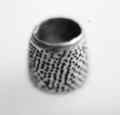
|
PE012. This is a perfectly useable and collectible silver copy of an
originally bronze Medeival thimble. It has no top and no bottom,
and is very typical of a Medieval European sewing accessory... I
thought that it would be quite beautiful strung on a simple cord and worn
as if it was a bead or a pendant... It measures a little more than
5/8" tall and the diameter across the top is 1/2" and across the bottom
is 5/8". I think it's an absolutely fascinating piece, especially since
I have seen ancient thimbles so rarely... $45.00 US |
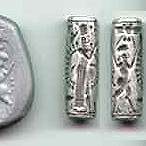
|
PE013. This is a silver copy of a pale carnelian Neo-Assyrian cylinder
seal. It portrays Ishtar, the sun goddess, in her starry radiance--standing
surrounded by a nimbus of stars and wearing a horned miter. Her long
robe is open in front revealing a short, bordered garment. A worshipper
in a long fringed garment points to the goddess with his right hand and
holds his left palm upward. Behind the goddess is a naked scorpion
man wearing a miter. His hands are raised up, possibly to support
the winged disc (symbol of the sun) above him. In the field are a
crescent and eight globes. The scorpion man (of the constellation Scorpio),
in supporting the winged disc, illustrates his super human and protective
nature. The worshipper may be a Neo-Assyrian king of the 9th or 8th
century B.C., the period when this drilled style was favoured in Assyria.
This seal was worn strung around the neck as a bead. 1 1/16" long.
ALL SOLD |
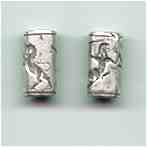
|
PE014. This is a copy of a Persian cylinder seal from about 500
B.C. The original is pale, transluscent stone (a slightly orangey
quartz) and the design is unfortunately fairly difficult to see.
In silver, the design is transformed to be both clear and exciting.
This is a "warrior" scene composed of a Centaur (a creature with the body
and legs of a horse, and the torso, head, and arms of a man) spearing a
lion. The Centaurs lived on Mount Pelion in Thessaly and were brutal
and lascivious creatures. They were also brave and indomitable warriors.
The artwork is both graceful and very attractive. Just under
3/4" long and 3/8" in diameter. This seal was holed as a bead and
worn around the neck to be used to make an impression in wax or a similar
material to seal or "sign" messages and documents.
ALL SOLD |
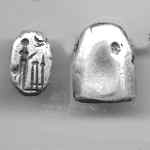
|
PE015. This is a heavy, solid siver casting of a Neo-Babylonian
stamp seal that was loaned to me by a generous collector in California.
The original seal was carved in tan coloured chalcedony and dates from
the 6th to 5th century B.C. A hole was drilled across the top of
the seal so it could be worn suspended from a cord around the neck.
The casting measures 5/8" x 3/8" x 3/4" and has a very pleasing weight.
It depicts a worshipper standing before an altar surmounted by the spade
of Marduk, chief god of Babylon, and the stylus of Nebu, the god of writing.
There is a small crescent moon above the altar. A similar seal can
be seen in "Near Eastern Seals" by Dominique Collon (p.12). On page
53, Collon points out that the Babylonian word for spade is "mar", so its
use as a symbol by Marduk may be both a pun and a reflection of his possible
origins as an agricultural god. $85.00 US |
 BACK TO CONTENTS PAGE
BACK TO CONTENTS PAGE